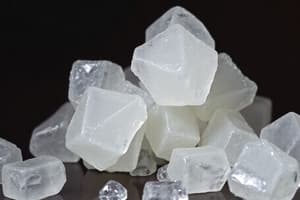Podcast
Questions and Answers
What type of glycosidic linkage is present when the monosaccharide is positioned upwards?
What type of glycosidic linkage is present when the monosaccharide is positioned upwards?
- Alpha glycosidic linkage
- Sigma glycosidic linkage
- Omega glycosidic linkage
- Beta glycosidic linkage (correct)
Which of these is NOT a common disaccharide?
Which of these is NOT a common disaccharide?
- Maltose
- Sucrose
- Cellulose (correct)
- Lactose
What is the main function of cellulose in the diet?
What is the main function of cellulose in the diet?
- Quick energy source
- Support and rigidity (correct)
- Digestion blocker
- Fat storage
Which blood type contains an additional D-galactose unit?
Which blood type contains an additional D-galactose unit?
What is a characteristic of polysaccharides?
What is a characteristic of polysaccharides?
Sucrose is made up of which two monosaccharides?
Sucrose is made up of which two monosaccharides?
Which polysaccharide is made up of repeating glucose units joined by 1-4 beta glycosidic linkages?
Which polysaccharide is made up of repeating glucose units joined by 1-4 beta glycosidic linkages?
Which blood type is considered the universal recipient?
Which blood type is considered the universal recipient?
What type of fatty acids do saturated triacylglycerols contain?
What type of fatty acids do saturated triacylglycerols contain?
Which phospholipid contains two nonpolar tails and a polar head?
Which phospholipid contains two nonpolar tails and a polar head?
What is the main component of most cell membranes?
What is the main component of most cell membranes?
What distinguishes polyunsaturated triacylglycerols from other types?
What distinguishes polyunsaturated triacylglycerols from other types?
What is a common outcome of the complete metabolism of triacylglycerols?
What is a common outcome of the complete metabolism of triacylglycerols?
Which characteristic of phospholipids is true?
Which characteristic of phospholipids is true?
Which polysaccharide is stored in animals and has a structure similar to amylopectin?
Which polysaccharide is stored in animals and has a structure similar to amylopectin?
What type of lipids can be converted into smaller molecules through hydrolysis?
What type of lipids can be converted into smaller molecules through hydrolysis?
What defines polyunsaturated fatty acids?
What defines polyunsaturated fatty acids?
What are essential fatty acids?
What are essential fatty acids?
What is the main source of energy for the body?
What is the main source of energy for the body?
Cis fatty acids are characterized by which of the following?
Cis fatty acids are characterized by which of the following?
Which enzyme is responsible for the digestion of amylose?
Which enzyme is responsible for the digestion of amylose?
Which fatty acid is classified as omega-3?
Which fatty acid is classified as omega-3?
Which type of reaction involves the conversion of a carbonyl group of an aldose to a primary alcohol?
Which type of reaction involves the conversion of a carbonyl group of an aldose to a primary alcohol?
What type of glycosidic linkages does amylopectin contain?
What type of glycosidic linkages does amylopectin contain?
What distinguishes trans fatty acids from cis fatty acids?
What distinguishes trans fatty acids from cis fatty acids?
Which of the following describes derived lipids?
Which of the following describes derived lipids?
Which statement about blood types is correct?
Which statement about blood types is correct?
What is a characteristic of fats compared to oils?
What is a characteristic of fats compared to oils?
Which type of molecule is defined as being lighter than water?
Which type of molecule is defined as being lighter than water?
What type of fatty acids are found in oils that have a lower melting point?
What type of fatty acids are found in oils that have a lower melting point?
What role do peripheral proteins play in the cell membrane?
What role do peripheral proteins play in the cell membrane?
What describes the structure of phospholipids?
What describes the structure of phospholipids?
What type of transport is required for large molecules to pass through the cell membrane?
What type of transport is required for large molecules to pass through the cell membrane?
Which statement is true regarding lipoproteins?
Which statement is true regarding lipoproteins?
What is the function of the 'heads' of soap molecules?
What is the function of the 'heads' of soap molecules?
Which of the following best describes the structure of the cell membrane?
Which of the following best describes the structure of the cell membrane?
What characterizes the fatty acid composition of oils derived from plants and fish?
What characterizes the fatty acid composition of oils derived from plants and fish?
Flashcards are hidden until you start studying
Study Notes
Fructose and Carbohydrates
- Fructose is a component of sucrose and classified as a ketohexose, known for being twice as sweet as glucose.
- Carbohydrates, including sugars and starches, are polyhydroxy aldehydes or ketones, or compounds that can be hydrolyzed into them.
- Disaccharides comprise two monosaccharide units linked via glycosidic linkage, categorized into alpha and beta based on the linkage orientation.
- Monosaccharides such as glucose, fructose, and galactose combine to form disaccharides like sucrose (glucose + fructose), lactose (galactose + glucose), and maltose (glucose + glucose).
- Polysaccharides consist of three or more monosaccharides; examples include cellulose, starch, and glycogen.
Blood Types and Monosaccharides
- There are four human blood types: A, B, AB, and O, which are determined by specific monosaccharide combinations.
- Type A blood contains a monosaccharide unique to it, while type B includes an additional D-galactose unit, AB has both, and type O is a universal donor.
Polysaccharides
- Cellulose is structured from glucose units joined by 1-4 beta glycosidic linkages, providing rigidity and making it undigestible, thus constituting insoluble fiber.
- Starch, composed of glucose linked by alpha 1-4 glycosidic linkages, is digestible, found in corn, rice, wheat, and potatoes. It exists as amylose (unbranched) and amylopectin (branched).
- Glycogen is a storage polysaccharide in animals, similar in structure to amylopectin and highly branched, primarily stored in liver and muscles.
Lipids Overview
- Lipids are biomolecules soluble in organic solvents, insoluble in water, and characterized by diversity in structure and function.
- They serve as a major energy source for the body and are lighter than water.
Classification of Lipids
- Hydrolyzable lipids can be broken down into smaller molecules through hydrolysis and include waxes, triacylglycerols, and phospholipids.
- Non-hydrolyzable lipids cannot be cleaved by hydrolysis and include steroids and fat-soluble vitamins.
- Lipids can be categorized as simple (esters of fatty acids) or complex (contain additional molecules).
Essential Fatty Acids
- Essential fatty acids are those the body cannot produce, including alpha-linolenic acid (omega-3) and linoleic acid (omega-6).
Fatty Acid Structure
- Cis fatty acids have hydrogens on the same side of the double bond, creating a kink, while trans fatty acids have hydrogens on opposite sides, resembling saturated fat structure.
Phospholipids and Cell Membrane Structure
- Phospholipids, including phosphoacylglycerols, are key components of cell membranes, with a polar head and nonpolar tails.
- Cell membranes comprise proteins, cholesterol, and carbohydrates, forming glycolipids and glycoproteins to aid molecule transport.
- Integral proteins span the bilayer, while peripheral proteins are attached to one side, allowing molecules to pass through via facilitated transport.
Triacylglycerols and Hydrolysis
- Triacylglycerols can be either saturated (only saturated fatty acids) or unsaturated (contain at least one unsaturated fatty acid).
- The hydrolysis of triacylglycerols could involve soap synthesis, where metal salts of fatty acids are formed through saponification, resulting in heads soluble in water and tails soluble in oil.
Studying That Suits You
Use AI to generate personalized quizzes and flashcards to suit your learning preferences.




